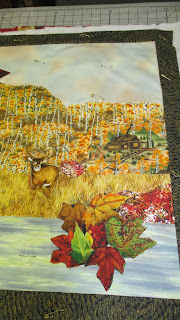When Gay Boomers of Sentimental Stitches saw an 1857 Album quilt it caught her interest. The original quilt was machine quilted. When she won the auction for the quilt Gay decided to draft patterns based on the 64 blocks and share them through her website.
 |
| 1857 Album quilt top by Nancy A. Bekofske |
Beginning in January 2016 Gay released several block patterns a month, free of charge.
A Facebook page was set up so those who were making the quilt could share their progress.
 |
| Some of the first blocks from 1857 Album |
I finally completed my quilt top. There is a border pattern available but I don't need a quilt that large. I have substituted some patterns with my own inventions.
 |
| I created the inkwell to reflect my interest in writing |
The patterns are now for sale at her website at http://sentimentalstitches.net/free-stuff/block-of-the-month-quilt-designs/the-1857-album-quilt/
 |
| 1857 Album block |
It was interesting to have found a 1938 magazine article by Florence Peto with a quilt that is very similar to Gay's. The border Gay offers is similar to the one in the quilt in the article.
 |
| 1857 Album block |
I shared the entire article at
https://theliteratequilter.blogspot.com/2016/01/old-quilts-tell-story-by-florence-peto.html
 |
| I used green, red, and orange as my main applique colors |
Here is the part of the article in which Peto describes the Houseman quilt:
"Although little verifiable biography enlightens the genesis of the merry Housman Quilt, the spirit of a locality animates it and it is vibrant with sentiment, symbolism, and the interests of a family. It was made in 1859, which is not old as quilts go. The present owner inherited it from an aunt whom she had seldom seen and she knows only that it was made in the Housman family which had Dutch ancestry; historical records show them to have lived on Staten Island as early as 1675. It is believed that some young son of the Housmans emigrated to Pennsylvania where he married a girl born and bred to German traditions. Being, therefore, well versed in local folklore, her patchwork took on the exuberant quality of a regional document which, at her passing, went to the Staten Island branch of the family.
 |
| The Houseman Quilt |
"Occupying central position is the red calico homestead with building-stones, and chimneys embroidered in chain stitches; ornamental stitchery is so often seen superimposed on the appliqué work of Pennsylvania-made quilts, it is tempting to call it characteristic. On both sides of the date have been placed pineapples, domestic symbol of hospitality. One of them, pieced of tiny rectangular patches hardly as large as your own small fingernail, has acquired a remarkable realistic effect. Left of center are two formalized trees of life, a little stark and primitive, but often seen in this form on other pieces of local handiwork. On each side of the house are more naturalistic, fruit-bearing trees under whose branches cocks and hens strut and feed. Baby's hands, scissors, and the baby's cradle over which hovers the dove, in this instance symbol of innocence, suggest woman's occupations. The capacious coffee mug, fancifully inscribed "John Demorest" and the Masonic and Odd Fellows' emblems, indicate masculine tastes and interests. There is speculation in the meaning of the Punch-and-Judy-looking figures; they may be Grandpa and Grandma Horseman; one or both may have had the disconcerting habit of mislaying his or her spectacles. Under the debonair horseman in orange breeches and green coat, "Euphemia" is stitched in outline; there is sad implication in the little riderless pony, who, by the way, carries an English saddle.
"Of not so personal but more general interest are the flower forms. Left of the house is seen a conventionalized passion flower. The lute as a motif was often employed by music-loving people, while oak leaves (top row, right of center) bring to mind German songs and stories; it is written that in ancient oak groves Germanic forebears worshiped their gods and held their communal assemblies. In Pennsylvania the double rose, fuchsia, pomegranate, and tulip are constantly recurrent motifs in the adornment of dower chests, household utensils, and needlework.
"Your old quilt may be decorated lavishly with hearts or there may be just one tucked away unobtrusively in a corner; the presence of a heart or dove indicated a bride's quilt. In the Housman Quilt a circle of hearts has been arranged in a round patch. The Star and Crescent (upper right-hand corner of the quilt) painted on a barn was a potent talisman to ward off unfriendly spirits from cattle and still other symbols had the property to insure prolific increase. Left of the Star and Crescent is the St. Andrew's Cross; though more often placed in a circle, in this quilt it has been set in a square. The St. Andrew's Cross, sure protection against sorcery, was a favorite hex mark. For instance, a witch, placing her hand on a door-knocker into which the occupant of the house as previously had the foresight to cut a St. Andrew's Cross, would be rendered helpless and impotent. Tools and guns, so marked, never disappeared or behaved badly.
"In the Housman quilt a green leaf appliquéd close to the corner of each unit block becomes a group of four leaves when the blocks are set together; leaves cut in three lobes supply a pleasing border finish. this piece is owned and shown by courtesy of Mrs. Frank Carroll."
I enjoyed working on this quilt for nearly two years! Now....to get it quilted!
























